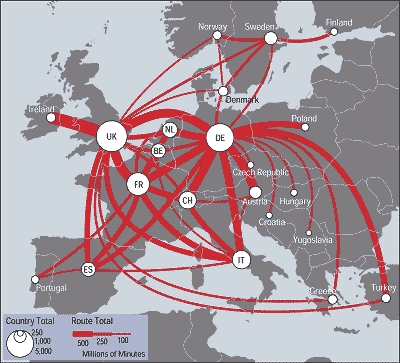 |
|
|
|||||||||||||||||||
|
TeleGeography's Traffic Flow Maps
Mapping the flows of goods, people, diseases, and the like between cities and countries has long been an important part of cartography. If you look in any good atlas you will find a range of different flow maps, but what you won't see are maps of the communication flows of the Net. This is because no one really knows, comprehensively and reliably, how much information and communications flows between cities and countries and few people have tried to map these flows. One group that has tried is TeleGeography [1], which has produced arguably the best flows maps of the Net thus far, based on the volume of international telephone traffic between nations. Below is an example of one of their handcrafted telecommunications traffic flow maps for the European region.
The map shows countries with traffic flows between them represented as smoothly curving red lines. The thickness of the lines is proportional to the annual volume of traffic between those two countries, measured in millions of minutes of voice telecommunication. (Note: only the principal route pairs, above a set threshold, are shown, to avoid cluttering the map.) Circular symbols, located on the capital city, encode the country's total annual outgoing traffic to all other countries. It is clear from the map that the UK, Germany, and France dominate traffic intra-European flows, forming a powerful triangle at the heart of the continent.
What is 'telegeography'? Well, it is a successful telecoms research company based in Washington DC, started by Gregory C. Staple in the early 1990s. It has also been defined as a new domain of study in a dictionary style as follows, telegeography \ n (1990) abbrv. of telecommunication geography [fr. Gk tele, far off, at a distance and L. communicatus, pp. of communicare to impart + fr. Gk geo (earth) + graphein, (to write)] 1. a new branch of geography that maps the pattern of telephone traffic and other electronic communication flows; 2. places created by or perceived solely via telecommunications (e.g., a computer network address); 3. the telecommunications artefacts (radio antennae, terminals, signs) on a site; 4. the balance of telecommunications power in one country or region vis-ˆ-vis another (cf. geopolitics, archaic). In a recent email interview for Map of the Month, I asked Greg Staple about his interest in maps and his motivation for starting TeleGeography. Staple became a nascent telegeographer whilst working at a small London think-tank in 1988 and one of his key inspirations was provided by Stuart Brand's 1987 book The Media Lab [2]. In the book Brand noted the paucity of data on and maps of information flows, in contrast to the wealth of statistics on the movement of all manner of material goods. When Staple read about this, he said, “Well the picture just came into my mind with his words. And I knew I had to take a stab at it. At the time, I was a few streets away from one of London's best stocked book stores and I had had the same frustrating experience; the information society was everywhere, but you couldn't find a map of who was connected to whom to save your job.” When Staple returned to telecoms law practice in the US he kept working on the problem, gathering data, making contacts and with the encouragement of Hugo Dixon, a telecommunications journalist at the Financial Times, began analyzing and mapping international telecommunications traffic. After several years work TeleGeography was formed as a company in 1993 and by the mid 1990s useful and comprehensive traffic flows maps were being published annually. Staple has a passion for good cartography and its application in the venture of mapping cyberspace - see for example his 1995 article “Notes on Mapping the Net: From Tribal Space to Corporate Space” [3]. In another email answer he set forth his belief that, “... Maps of cyberspace or any information space can be of enormous help. We are just beginning to figure out the 'how' and the 'why' though. Currently, cybermaps are of limited navigational value, but they are beginning to help us track the Net's changing day-to-day topology.” The traffic flow maps are but one of the high-quality and innovative maps of the Net developed and published by TeleGeography, along with a range of comprehensive reports. More recently they have been mapping Internet bandwidth between countries, which also provides a useful proxy for information flows [4]. In addition, Staple asserts “the purely aesthetic dimension of cybermapping–a new genre for the arts–shouldn't be ignored either.” This can clearly be seen in TeleGeography's recent spin-off venture Peacock Maps [5] which is selling the glorious 'Whole Internet' posters, based on the research by Bill Cheswick and Hal Burch in Bell Lab's Internet Mapping Project [6].
Staple is happy that after ten years of work and development, telecommunications flow maps are at last beginning to be included in mainstream atlases [7], although, they only provide a partial view of the totality of information flows using the multitude of media available today. Staple notes, in his email answers, that we are still some way from meeting Brand's 1987 musing on the 'dream' information flow map, "One would want [the] map to be animated, depicting the flows in time series, showing where are the ebbs over time and where the floods and where the ancient streambeds, and how rapidly the torrent is growing. Other maps could show what is borne on the currents: what kinds of information are increasing, decreasing, blending?" (The Media Lab, by Stuart Brand (Penguin 1987), page 245). Hopefully, telegeographers from around the world are working to create these maps. Copyright © 1999, 2000 media.org. ISSN: 1530-3314 |
||||||||||||||||||||
|




